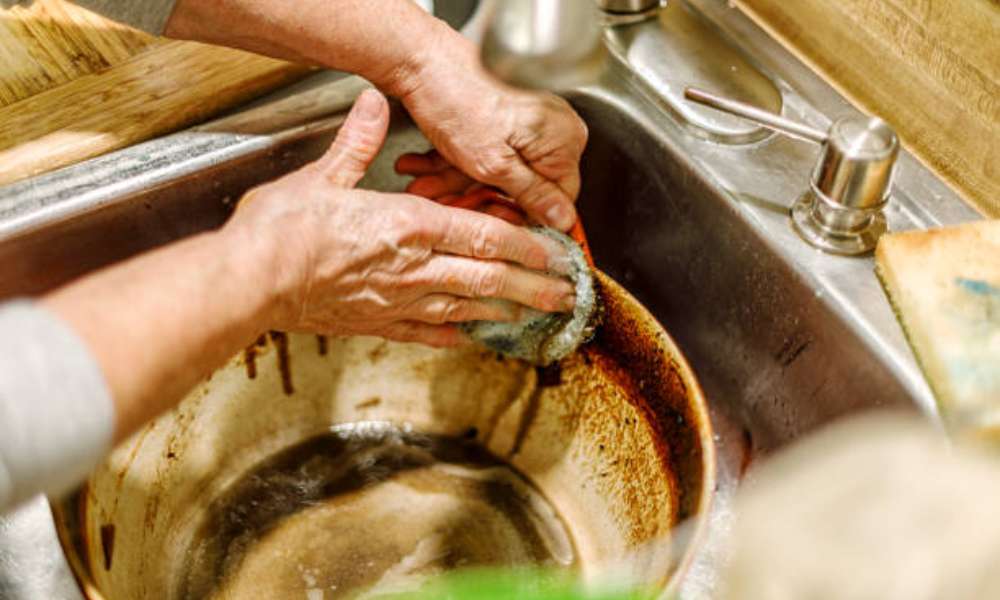Maintaining your cast iron Dutch oven is key to keeping it in excellent shape for years. Unlike regular cookware, cast iron demands special care to preserve its seasoning and prevent rust. In this guide, we’ll dive into how to wash cast iron Dutch oven, ensuring your kitchen essential stays as durable and functional as ever. From removing food residue to restoring seasoning, we’ll walk you through each step, so your Dutch oven remains your trusted companion for all your cooking adventures.
Understanding Cast Iron: Why It Demands Special Care
Cast iron isn’t like your regular pans. It’s porous. It breathes. When seasoned correctly, oils polymerize and form a non-stick shield that improves every dish you cook. But those pores? They’re also its Achilles’ heel. Left exposed, they can trap moisture and invite rust. Harsh scrubbing or using strong soaps strips away the protective seasoning. Once gone, you’re left with bare iron, which isn’t ideal for cooking. Understanding this delicate balance is key. You can’t treat cast iron like stainless steel. You need a gentler touch.
What You Will Need: Essential Tools and Supplies
Before diving into the process, gather these items:
- Soft Sponge Or Cloth
- Mild Dish Soap (Optional But Allowed)
- Non-Metallic Scouring Pad Or Brush
- Coarse Salt (For Stubborn Residue)
- A Towel For Thorough Drying
- Vegetable Oil Or Flaxseed Oil For Re-Seasoning
Using the right tools ensures you won’t scratch or strip your cast iron’s seasoning. Steel wool? A big no. Harsh chemicals? Even bigger no.
Before You Wash: Removing Food Residue with Care
No one wants stuck-on food after a long cooking session, but tackling it early helps. Scrape off leftovers with a wooden spatula. Don’t rush or use metal—gentle care preserves the surface. For stubborn, baked-on food? Fill the Dutch oven with water and heat it up. This loosens the residue. Once softened, the food practically slides off, saving you from a scrubbing headache.
How To Wash Cast Iron Dutch Oven Gently with Soap
A controversial topic: soap. Modern wisdom? It’s okay in moderation. After removing residue, apply mild soap to a sponge. Gently scrub the oven, inside and out. Keep it light—don’t scrub as though you’re cleaning stainless steel. Rinse thoroughly to banish all soap traces. Any leftover could ruin your next meal’s flavor.
The Right Way to Scrub: Tackling Stubborn Residue
Still have food that won’t budge? It happens. Instead of reaching for steel wool, grab coarse salt. Sprinkle generously into the Dutch oven and use a soft sponge or brush in circular motions. The salt’s abrasiveness lifts off stubborn food without harming the seasoning. Simple but effective.
Rinsing Properly: Soap and Salt, Begone
Rinse everything. Soap, salt—any lingering residue could lead to buildup, affecting both flavor and seasoning. Use warm water, making sure every last bit is gone. A clean rinse ensures your Dutch oven is ready for its next culinary task.
Drying Your Cast Iron Dutch Oven Completely
Here’s where many go wrong: letting it air dry. Big mistake. Even the tiniest water droplets will cause rust. Instead, dry your oven immediately with a towel. For extra precaution, place it on a low-heat burner to evaporate any remaining moisture. This step ensures its bone is dry and safe from rust.
Restoring The Seasoning: The Key To Long-Term Care
Once dry, it’s time to restore that precious seasoning. Grab vegetable or flaxseed oil, rub a small amount on a cloth, and coat the entire surface. Don’t forget the lid! Place the Dutch stove, upside down, in a 350°F preheated oven for an hour. This re-bakes the oil into the iron, creating that essential protective layer.
How To Store Your Cast Iron Dutch Oven to Avoid Rust
Once clean and seasoned, store your Dutch oven in a cool, dry place. To prevent moisture from being trapped, slide a folded paper towel between the lid and the pot. This small trick ensures air circulation and prevents rust from sneaking in.
What to Avoid, Common Mistakes When Wash Cast Iron Dutch Oven
Yes, there are pitfalls. Steel wool? Avoid it—it strips seasoning. Soaking in water? No way. It invites rust. And if rust does form, tackle it immediately. Letting it sit will only lead to more damage. Learn from these common mistakes to keep your Dutch stove in top shape.
Dealing with Rust: How To Restore Your Dutch Oven
Rust can happen. But don’t panic—it’s fixable. Start by scrubbing the rust with steel wool until it’s completely gone. Rinse, dry, and re-season as you would normally. Follow the same oiling and baking process to rebuild that protective layer. Your Dutch stove will be as good as new.
Deep Cleaning
Sometimes, a deeper clean is necessary—especially after cooking acidic dishes like tomato sauce. In this case, make a baking soda paste (baking soda + water) and gently scrub the inside. Rinse well, then re-season. This removes any lingering odors or stains without damaging the cast iron.
The Importance of Regular Care
Consistency is your best friend. Wash, dry, and season your Dutch stove after each use. This ritual prevents rust and maintains that glorious non-stick surface. Plus, cast iron only gets better with age. Treat it well, and it’ll serve you for generations.
Can I Use Soap On My Cast Iron Dutch Oven?
Yes, mild soap is fine if used sparingly and followed by re-seasoning.
How Do I Prevent Rust On My Cast Iron?
Make sure it’s completely dry before storing, and always apply a thin layer of oil after each wash.
Conclusion
While it might seem daunting at first, caring for this Dutch stove is a breeze once you know the steps. Washing it properly not only preserves its functionality but also makes sure it remains a kitchen companion for years to come. Embrace the routine—it’s a small price to pay for a tool that gets better with each use. Proper care equals longevity, and in the case of cast iron, it’s always worth the effort.
